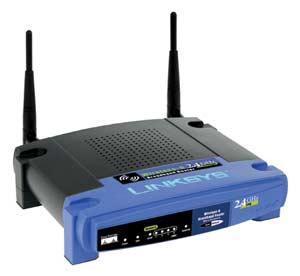[lang_en]After failing to configure more than one wlan onto my new wrt160nl, I’ll tried the same with my old wrt54gl.

The setup:
-One WLAN ( secure ) ,directly connected to my LAN
-One WLAN ( unsecure) , for testingpurpose only for a few hosts. This net wil be routed to the LAN.
The accessiblity will be managed by the Firewall and my dhcpd
The second wlan will simply added to /etc/config/wireless ( same physical interface)
config wifi-device wl0
option type broadcom
option channel 7
config wifi-iface
option device wl0
option network lan2
option mode ap
option ssid lulu
option encryption none
option hidden 1
option dns 192.168.1.1
option gateway 192.168.3.2
option dhcp 192.168.1.1
config wifi-iface
option device wl0
option network lan
option mode ap
option ssid lala
option encryption psk
option key secret
option hidden 1
option dns 192.168.1.1
option gateway 192.168.1.1
option dhcp 192.168.1.1
after a „wifi down && wifi up“ you’ll now see Interface wl0.1.
I had two change the following in the /etc/config/network
-I need a new vlan ( 2) . The Vlan1 was for the WAN Interface, the physical interface is now in VLAN 0 ( LAN) so I have 5 Interfaces for the LAN.
-For both WLANs you have to configure the bridge interfaces.
-under /etc/firewal.user you have to adapt the firewall .
#### VLAN configuration
config switch eth0
option vlan0 "0 1 2 3 4 5*"
option vlan1 "5*"
option vlan2 "5*"
#### Loopback configuration
config interface loopback
option ifname "lo"
option proto static
option ipaddr 127.0.0.1
option netmask 255.0.0.0
#### LAN configuration
config interface lan
option type bridge
option ifname "eth0.0"
option proto static
option ipaddr '192.168.1.98'
option netmask 255.255.255.0
option gateway '192.168.1.1'
option dns '192.168.1.1'
##### VLAN 2 , Bastenwlan
config interface lan2
option type bridge
option ifname "eth0.2"
option proto static
option ipaddr '192.168.3.2'
option netmask '255.255.255.0'
option dns '192.168.1.1'
option dhcp '192.168.1.1'
thats all
[/lang_en][lang_de]
Nachdem ich scheiterte, dem WRT160NL mehr wie ein Wlan beizubringen . Deswegen stürzte ich mich auf meinen alten Router WRT54gl und siehe da, es geht doch.

Das Szenario:
-Ein WLAN ( sicher ) ,das direkt mit dem LAN verbunden ist
-Ein WLAN ( unsicher) , für Testzwecke, das in das Haupnetz geroutet wird und nur wenigen ausgesuchten Hosts offensteht ( durch den dhcp und die Firewall geregelt )
Unten die /etc/config/wireless in der das zweite wlan einfach hinzugefügt wird ( gleiches physkalisches Interface)
config wifi-device wl0
option type broadcom
option channel 7
config wifi-iface
option device wl0
option network lan2
option mode ap
option ssid lulu
option encryption none
option hidden 1
option dns 192.168.1.1
option gateway 192.168.3.2
option dhcp 192.168.1.1
config wifi-iface
option device wl0
option network lan
option mode ap
option ssid lala
option encryption psk
option key secret
option hidden 1
option dns 192.168.1.1
option gateway 192.168.1.1
option dhcp 192.168.1.1
nach einenm wifi down && wifi up ist nun das Interface wl0.1 entstanden.
In der /etc/config/network ist folgendes zu ändern.
-Ein neues vlan ( 2) ist anzulegen. Das Vlan1 war für das WAN Interface, da physikalischen Interface ist aber nun im VLAN 0 ( LAN). So habe ich in meinem WLAN 5 Interfaces
-Für die Beiden WLANs werden die beiden Bridge Interfaces konfiguriert.
-unter /etc/firewal.user ist noch die Firewall anzupassen.
#### VLAN configuration
config switch eth0
option vlan0 "0 1 2 3 4 5*"
option vlan1 "5*"
option vlan2 "5*"
#### Loopback configuration
config interface loopback
option ifname "lo"
option proto static
option ipaddr 127.0.0.1
option netmask 255.0.0.0
#### LAN configuration
config interface lan
option type bridge
option ifname "eth0.0"
option proto static
option ipaddr '192.168.1.98'
option netmask 255.255.255.0
option gateway '192.168.1.1'
option dns '192.168.1.1'
##### VLAN 2 , Bastenwlan
config interface lan2
option type bridge
option ifname "eth0.2"
option proto static
option ipaddr '192.168.3.2'
option netmask '255.255.255.0'
option dns '192.168.1.1'
option dhcp '192.168.1.1'
thats all
[/lang_de]

 Nachdem der Router ein Jahr lang unnütz in der Ecke stand gab ich ihm eine weitere Chance.
Nachdem der Router ein Jahr lang unnütz in der Ecke stand gab ich ihm eine weitere Chance.
